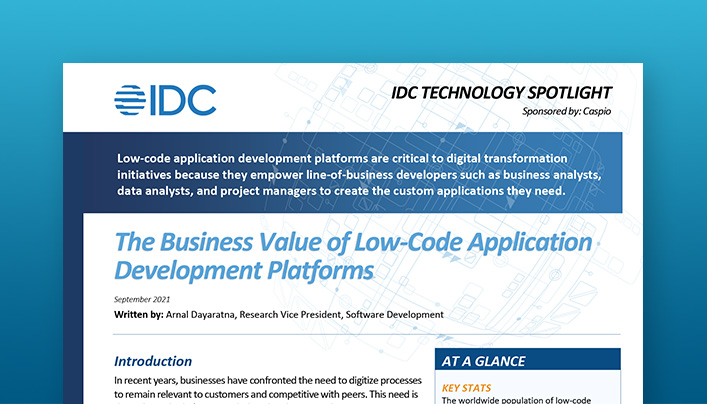Startups: Accelerating Growth With 10x Time-to-Market
NO CODE 2018: Caspio for Startups and SMBs
So, a little information about Roost. Michelle mentioned we’re a startup here in Silicon Valley. Our primary focus is selling to insurance companies, who then provide our smart home technology to their policyholders with two aims.
One aim is to mitigate loss, and another aim is to engage policyholders with our co-branded mobile app, which you’ll see here at the far left. Now, this is not a Caspio web app. This is a true mobile app developed on Android and Apple platforms.
And these are our smart sensors. I’ve had side conversations with many people today, and they’ve said, “What are your products?” Well, here they are.
We have a smart garage door sensor on your left, a Roost smart nine-volt battery in the center, and then our smart water leak and freeze detector. So, these are little sensors.
If you’re familiar with smart home technology, you might not know these products. But, how many of you have a Google Home or Alexa? All right, got it. People have those. So, these products are similar technology.
You connect these to your Wi-Fi network using our mobile app, and then they do really cool things. We’ll talk about that in a second.
Just a little background about me. While I was growing up, I wanted to be a no-coder. So, that’s why I’m here.
I don’t have a coding background. I am an engineer, but from many, many, many years ago, and I haven’t done engineering work for many years. And I was a mechanical engineer, so I built things that look like this, not code.
Protecting Customers Through Technology
What we’re trying to do is we work with large insurance partners to get our smart home devices to their policyholders for two reasons.
One is to mitigate loss – catch a water leak before it becomes really bad, catch a smoke, catch a small fire in your kitchen before it spreads to your whole house – save those insurance companies money.
Another reason is to engage policyholders through a co-branded mobile app. Sounds easy, right?
Amazon ships packages every day, next-day delivery, sometimes same-day delivery. It’s incredibly complex.
I really love Frank’s iceberg. I think it was Frank who had the iceberg image on one of his slides with the customer journey. At the top is, “This is what the customer sees,” and then there’s all that other stuff going on below.
I’m involved in all that other stuff, and I’ll talk more about what we’re doing.
This is a photo from actual Roost customers, Tom and Donna. They sent us this photo. It came in over the weekend into our support email, and they said, “You guys saved my house.”
This is with our smart nine-volt battery. Tom had just installed it in his smoke detector the weekend before. And lo and behold, he is away at work. He gets an alert on his smartphone. It’s like, “Wow, what’s going on?” He calls his neighbor because his nearest neighbor is a half-mile away. The neighbor drives over, sees the smoke, calls 911, the house is saved. That is of value to an insurance company and to a policyholder.
Actually, we get more emails on the Roost leak detector catching problems.
This was during Hurricane Florence in North Carolina. This gentleman’s crawlspace was leaking because he had a blocked drainpipe, and the Roost leak detector alerted him on his smartphone. He went outside in the pouring rain, fixed the problem, and saved himself some hassle. So, those are end-users; I just told you end-user stories.
Continuously Increasing Client Base and Incurring More Data
We sell to insurance companies. These are some of our insurance partners. You may recognize some names; some others may be less familiar to you.
Desjardins, the largest insurance provider in Canada. Aviva, a very large insurance provider in the UK. GuideOne. Who knew there’s an insurance company that sells just to churches right here in the US? It covers 50,000 churches.
These are very large partners. And we work with them on that customer journey, getting information from them about their policyholders, doing what we call a qualification or registration of those policyholders, getting devices to those policyholders, and then having other data associated with the device back to the insurance company.
A year ago, we had four to five logos on this slide. Now, we have 18, and we have even more that we haven’t announced that I can’t have on here. The train is running. We’re a startup of 20 people. And the train is running fast.
How do we scale? How do we grow?
The Need for an Online Database Application
A year ago, I started my first launch with one of these partners. As I explained to Michelle and the Caspio team, it was one of the most painful experiences I’d ever had in my career.
We had CSV files on Dropbox. We had data in SurveyMonkey that I would download to an Excel spreadsheet. We had data from a customer in an Excel spreadsheet.
It was truly death by Excel spreadsheets. I’m pretty good with Excel, and I can do VLOOKUP and PivotTables. But it was terrible. And I said, “I’m never going to do that again.”
So, the first thing needed to fix a problem is to identify it. The real challenge is, how do we handle all the customer data, and what’s a funnel?
Think of the situation as a funnel, which is our B2B2C customer journey in our supply chain, if you will. So that’s business-to-business, then to their consumers.
And how do we respond to different insurance company requests? Every one of those people on that slide had a slightly different request for how they wanted to do business. Another issue, insurance. There’s a lot of privacy stuff. How do we protect ourselves from data that we don’t want to see?
Ultimately, how do we create a single source of truth where we do not have data in multiple different places? I know this is a pain shared by many people with whom I’ve spoken at this conference. And I see the gentleman from Honda here, I think it’s Steven, right?
We don’t have a lot of resources. We’re a very small company. I know you’re maybe constrained on resources, too, Steven. Even though Honda’s a large company, it’s challenging to deal with that.
Considering Off-the-Shelf Applications and a Custom Application
So, we considered solutions, right? We’re smart people at a smart home company. Should we build the app ourselves? We have in-house database experts. We have an IoT cloud. That’s an internet of things cloud with a billion data events. We are no strangers to handling large amounts of data. So, should we build this ourselves?
As Michelle mentioned, we are focused on other things. We are building our products and services. We have a VP of Engineering with deep experience in the supply chain. Sorry, a VP of Operations with deep experience in supply chain. He worked at Logitech. There’s got to be solutions for this type of supply chain.
We looked at NetSuite. It didn’t quite fit the bill. Salesforce, I think everyone’s heard of Salesforce, right? Highly customizable. You can bring Salesforce in, and they can do a lot for dollars, which we didn’t have. And it really wasn’t the right solution anyway. ActiveCampaign is another lower-cost CRM. We use it for marketing automation, but it really wouldn’t allow us to do what we wanted to do.
So, from what I call a very deep point of pain, I started looking for other options, and I stumbled on Caspio.
It’s so funny to hear people mention Microsoft Access. I know nothing about Access. All I know is that when I started looking for a solution, I did look at Access. I’m like, “What does this do? And how easy is it to use? And could I do it?” And I talked to our CTO, who’s very much a coder. And he is like, “I could never figure out Microsoft Access.” I’m like, “Okay, dude. If you can’t figure it out, there’s no hope for me.”
So, I stumbled onto Caspio, probably about February of this year. And Michelle was great. I started playing around, trying to figure out what could I do with this. And each week, every day, I learned some new things that I could do with it.
We’ve gotten to the point now where we’ve built individual apps for our insurance partners that help with this process of getting their policyholders through our B2B2C funnel. The thing about Caspio is, in addition to building all these apps for our individual customers, we’ve gotten total flexibility at the top of our funnel. And what I mean by that is, how do our insurance partners get us data to get their customers through what is our Roost customer journey?
Accommodating Different Customer Requirements
I have a great story about API. In February of this year, I was in Quebec City with my boss, the chief marketing officer. Beautiful. Really, seriously beautiful in Quebec City, if you don’t mind cold in February.
Anyway, we had just finished up a four-hour meeting with one of our partners. We had an Uber ride to the airport, and we had another call scheduled during that Uber ride with a brand-new customer in the Midwest. The call was with the IT team of this Midwestern customer.
Me, I’m not IT. My boss, he’s for sure not IT. And then the IT team, so their conversation went like this.
“Well, we use Guidewire, which is the industry equivalent of Salesforce, and we want to send our data to you via API.” I said, “Okay.” “What data formats can you accept?”
I’m thinking, “Oh, I don’t know.” But what did I say? I didn’t say that. I said, “You know, whatever you want. How you want send it to us, we can handle that.” What was I going to say? But I’ll tell you the end of that story later.
Then a couple of months ago, we got a new request, another large insurance company in the Midwest. I don’t know about these Midwesterners. They said, “We need more detail. We need more real-time reporting on what you have in the funnel. What’s at the top? We need to see this.” I said, “Okay.”
And guess what? Caspio can do it for us.
Building Custom-Branded Apps Through Low-Code
Then there is this other thing of isolating customer data. We don’t want a piece of their data, and they want to give it to us. So, we came up with a happy medium.
We said, “Okay, we will buy another Caspio account. We will build the data table and the apps in that account. We will create a view without that data we don’t want to see, and then we’ll do a Git, do an API call to that view, and just pick up that data every five minutes. So, you’re happy. We’re happy.”
It was the perfect marriage. We turned the keys of that account over to them, the login. So, we don’t see the data. We only get what we want. When I started with Caspio, I had no idea we could do all this stuff. It’s so amazing.
So custom-branded apps. Each client has different requests. We’ve used templates now for rapid deployment to our clients. We can say yes to most requests with Caspio.
Caspio has a lot of continuous improvement and innovation. I learned things yesterday that I can now roll out across all our apps. That’s amazing. We really have delighted customers.
So that API story, they came back to us after we launched. Their IT director said, “That is the easiest integration we’ve ever done.”
All I did was give them the private ID and key for Caspio. I set up the web services or whatever they’re called, the app services, and gave them a little instruction on the information on Caspio’s website. It was awesome.
Choosing Caspio as a Cloud Database Partner
So, why Caspio?
Caspio allows us to be responsive. I think everyone would feel that way. Totally flexible. We have huge breadth with what we can do with Caspio.
And speed! No need to manage engineering resources. In fact, just last Friday, I had a conversation with my boss and said, “You know, David, these 60-hour weeks, they’re getting to me. I think I’d like to get someone else on board to help with Caspio. And should that person be in engineering?”
And the first thing David said to me was, “No, I want to keep control of that resource so we can be responsive to our customers.” And with Caspio, we can do that. The support. There are my support friends over there. Hima and Melody are not here. I mean, these guys are amazing. Every time I chat in, they’re like, “Oh, gosh, there’s Kim again.” But, you know, they help me. It’s made me feel that yeah, I’m not alone. And Michelle’s great, too.
So, the golden rules of startups. Eric Ries, most of you know him, said work harder. Sorry, he said, “Work smarter, not harder.”
Caspio allows us to do that. Me, you don’t know me. What I’ll tell you about a startup if you’ve never been in one, there’s a ton of dirty laundry.
So, what you need to do is to launder, rinse, learn, and repeat. Keep going and make sure you learn.
And oh, by the way, if you have a washing machine that leaks and you have a Roost smart water leak and freeze detector there, we will let you know on your smartphone.
Thank you, guys. You’ve been a great audience.




